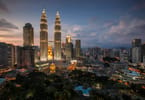Hong Kong’s gleaming glass and steel skyscrapers and its verdant Peak disappeared into a cloud of smog and dust as a sandstorm blowing from northern China brought record levels of pollution to the territory.
One side of Hong Kong harbour was barely visible from the other as the Government was criticised for failing to warn residents that the cloud of noxious air was bearing down on the city.
Residents awoke on Monday to a pall of choking murk, borne by easterly winds along the coast, that caused already high pollution readings to jump six-fold to a record high.
Readings around the city were pushed over the top of the 500-point air pollution index and into previously uncharted territory. The previous highest recorded pollution level was 202, in July 2008.
Doctors said there was little people could do to protect themselves because ordinary surgical masks could not block the particles. Even staying indoors with the air conditioning on was no guarantee of safety.
The quality of the air in Hong Kong has become a controversial social issue in recent years, tarnishing the city’s reputation as a financial hub compared with greener rivals such as Singapore. It has also affected the health of many citizens.
The Hong Kong authorities have tried to clean up emissions from vehicles and power stations, but they are unable to control pollution blowing in from China. Much of the smog in recent years has been blamed on pollutants emitted by the tens of thousands of factories in southern China’s manufacturing hub.
The worst sandstorms have been reported around Beijing, where the air quality index reached the most serious level as the city’s sky turned orange on Saturday. A mixture of sand and pollution blowing in from the Gobi Desert to the north dumped about 150,000 tonnes of yellow dust on the capital at the weekend.
Resident and Tourists were warned to stay indoors.
China’s expanding deserts now cover one-third of the country because of overgrazing, deforestation, urban sprawl and drought. The shifting sands have led to a sharp increase in sandstorms – the grit from which can travel as far as the western United States.
WHAT TO TAKE AWAY FROM THIS ARTICLE:
- A mixture of sand and pollution blowing in from the Gobi Desert to the north dumped about 150,000 tonnes of yellow dust on the capital at the weekend.
- The quality of the air in Hong Kong has become a controversial social issue in recent years, tarnishing the city's reputation as a financial hub compared with greener rivals such as Singapore.
- One side of Hong Kong harbour was barely visible from the other as the Government was criticised for failing to warn residents that the cloud of noxious air was bearing down on the city.






















